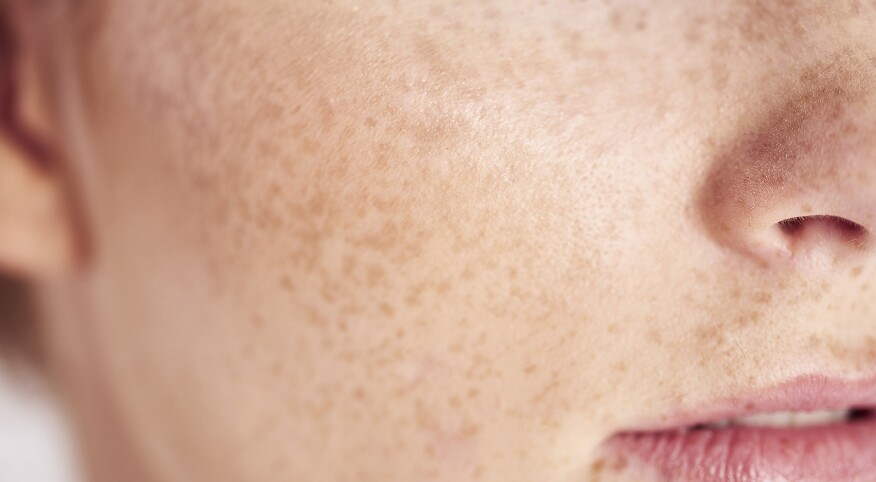I’m sitting in my dermatologist’s office, dressed in a paper robe. My doctor holds a magnifier up to my skin and attempts to examine the spots scattered across my body, but there are just too many. Every so often he pauses, unsure where to look next. As his eyes scan my pale frame, he says, in awe, “You are a walking billboard for skin cancer.”
When I was a girl, sunburns were a given. The 1980s were the years of baby oil and trifold sun reflectors, a time when the goal was a complexion the color of tanned leather. Because of my pasty skin, I knew to apply sunscreen in the morning before going out, but I never reapplied — even after hours outdoors. My negligence was intentional; I resented my appearance. I was tired of the jokes about my ghostly pallor.
“Whoa! I’m blind,” a friend would joke when I stepped onto the beach in my swimsuit.
“You look sick. You need some color,” a well-meaning relative would advise.
I took these comments to heart, doing all I could to get that healthy glow so often displayed in magazines. But my attempts only resulted in skin that looked fried.
I often returned home from trips to the beach with burns covering my body. Heat would radiate off my bright red limbs as blisters formed on my forearms. I’d grab the aloe vera stored in the fridge and lather it on the way I should’ve used the sunscreen — in gobs rubbed over every inch of burnt flesh. Then I’d pop some ibuprofen, lie on a cold sheet and wait for the pain to subside. Soon after I’d be back to sunbathing outside, with little concern for the rays shining down from above.
It took many years of burning, peeling and burning again, but by the turn of the century, I’d finally outgrown my careless ways. Frightened by stories of premature aging, I applied and reapplied sunscreen daily, kept out of the sun, and scheduled annual skin-care checkups. I was 26 when the first questionable mole appeared. My doctor scooped it out of my back, leaving a small crater in its wake. The mole was benign, so I assumed that meant I’d changed my ways in time. I hadn’t had a sunburn in years and was proud of myself for saving my skin before any damage was done.
But when I turned 30, small dots in varying shades of brown appeared on my upper body. At first, there were just a few freckles. But over the next couple years, the dots expanded and multiplied. My arms took on the appearance of a speckled egg, while my shoulders, where the dots joined together to form larger blotches, looked like a sepia-toned Jackson Pollock painting.
The medical term for these freckly areas is solar lentigines, patches of dark spots commonly referred to as liver spots or age spots, so named because they typically appear after 40 and into older age. Yet here I was, in my early 30s, with brown blemishes forming all over my body.
I panicked over the thought of having blotchy, weather-beaten skin, and pored through magazines for solutions. I bought expensive serums to promote collagen production. I stocked up on moisturizers that promised to fade spots. I got a prescription for bleaching ointment to halt further discoloration. None of it worked.
The spots spread to my forehead, nose and jaw. I’ll cover them with makeup, I reasoned. No one will notice. But one day, while in a public restroom, I looked at myself in the mirror. Sunlight streamed through a small window, providing more natural light than the bulbs in my bathroom at home. The spots weren’t subtle. They weren’t covered by makeup. They were right there, obvious, peppering my face.
I stared at my reflection, on the verge of tears. What had I done to myself? I’d wanted so badly to look attractive to others that I’d put myself at risk. I wasn’t yet 40 and my skin was already showing signs of long-term damage. I couldn’t ignore the havoc I’d wreaked; all those years of sunbathing had caught up to me.
Now I’m on the table and in the robe, reeling from my dermatologist’s “walking billboard” comment. He finds yet another questionable mole, which he will remove. Like the others, it is benign. But that isn’t my concern; I’m worried about my appearance. I casually mention the facial spots, hoping he’ll say they’re not so bad. “Yes, I see them,” he says. “There’s nothing you can do. Just keep wearing sunscreen, avoid the sun, and hope they don’t get worse.” I’m dejected. I want him to hand over a salve that will eradicate the ugly brown dots forever. But as I sit, sulking and envisioning a future in which I’m forced to hide my hideous visage from the world, he turns to me and says, “You know, it could be a lot worse. You’ve been lucky, given your history of burns.”
Suddenly, my perspective shifts. I’ve had multiple moles removed. I know the danger caused by exposure to ultraviolet radiation. I know I’m at risk for melanoma because of my many burns. These spots exist because of my carelessness. But in thinking of them as a nuisance, something to cover or erase, I’m missing the message.
Maybe my skin doesn’t have that sun-kissed glow so often associated with health and vitality, but I’m healthier now than I ever was with a burn. I’m happy to embrace my dappled, pale complexion, which reminds me every day to ignore the naysayers, love the skin I’m in — and slather on the sunscreen.

Getty Images








